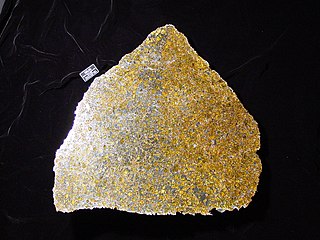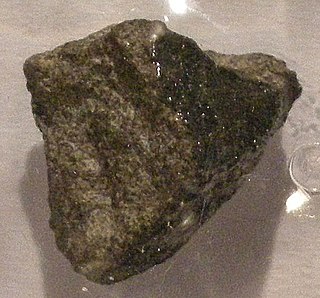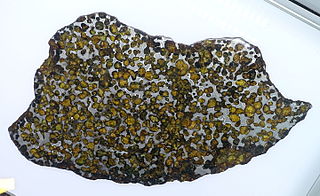Strewn field
Meteorites were found in a zone about 15 kilometres (9.3 mi) long and 3 kilometres (1.9 mi) wide crossed by the Dnieper River.
The area was contaminated in 1986 during the Chernobyl disaster and falls now in the Periodic Control Zone. Post-accident recovered meteorites are safe and not contaminated because the radiation affects only the first few inches of soil, nevertheless meteorite hunting in the area is not entirely safe.
The official total known weight is 1,050 kilograms (2,310 lb), but it is probably underestimated.

A meteorite is a solid piece of debris from an object, such as a comet, asteroid, or meteoroid, that originates in outer space and survives its passage through the atmosphere to reach the surface of a planet or moon. When the original object enters the atmosphere, various factors such as friction, pressure, and chemical interactions with the atmospheric gases cause it to heat up and radiate energy. It then becomes a meteor and forms a fireball, also known as a shooting star; astronomers call the brightest examples "bolides". Once it settles on the larger body's surface, the meteor becomes a meteorite. Meteorites vary greatly in size. For geologists, a bolide is a meteorite large enough to create an impact crater.

Campo del Cielo refers to a group of iron meteorites and the area in Argentina where they were found. The site straddles the provinces of Chaco and Santiago del Estero, located 1,000 kilometers (620 mi) north-northwest of Buenos Aires, Argentina and approximately 500 kilometres (310 mi) southwest of Asunción, Paraguay. The crater field covers 18.5 by 3 kilometres and contains at least 26 craters, the largest being 115 by 91 metres.

The pallasites are a class of stony–iron meteorite.

Imilac is a pallasite meteorite found in the Atacama Desert of Northern Chile in 1822.

The Fukang meteorite is a meteorite that was found in the mountains near Fukang, China in 2000. It is a pallasite—a type of stony–iron meteorite with olivine crystals. It is estimated to be 4.5 billion years old.

Mesosiderites are a class of stony–iron meteorites consisting of about equal parts of metallic nickel-iron and silicate. They are breccias with an irregular texture; silicates and metal occur often in lumps or pebbles as well as in fine-grained intergrowths. The silicate part contains olivine, pyroxenes, and Ca-rich feldspar and is similar in composition to eucrites and diogenites.

Stannern meteorite fell on May 22, 1808 into the Moravian village Stonařov, in today's Czech Republic.

Esquel is a meteorite found near Esquel, a Patagonian town in the northwest part of the province of Chubut in Argentina. It is a pallasite, a type of stony–iron meteorite that when cut and polished shows yellowish olivine (peridot) crystals.

Brenham is a pallasite meteorite found near Haviland, a small town in Kiowa County, Kansas, United States. Pallasites are a type of stony–iron meteorite that when cut and polished show yellowish olivine (peridot) crystals.

Krasnojarsk was the first pallasite meteorite ever found.

Huckitta is a pallasite meteorite recovered in 1937 from Huckitta Cattle Station in the Northern Territory of Australia.
Omolon is a meteorite fallen in 1981 in the Omolon River basin, Magadan (Russia). It is a pallasite.

Park Forest is an L5 chondrite meteorite that fell on 26 March 2003 in Illinois, United States.

Gao–Guenie is a H5 ordinary chondrite meteorite that fell on Burkina Faso, West Africa, on March 5, 1960. The fall was composed of many fragments and it is one of the largest observed meteorite showers in Africa to date.

Pallasovka is a pallasite meteorite found in 1990 near the town of Pallasovka, Russia.

Seymchan is a pallasite meteorite found in the dry bed of the river Hekandue, a left tributary of river Yasachnaya in the Magadan district, Russia, near the settlement of Seymchan, in June 1967.

The Yardymly meteorite is an iron meteorite that fell in Yardymli Rayon, Azerbaijan on November 24, 1959. The remains were discovered in the nearby village of Aroos. With five individual specimens, the total weight of the meteorite is estimated at 150.29 kilograms (331.3 lb). The meteorite is kept in the Institute of Geology of Azerbaijan National Academy of Sciences. According to the director of Şamaxı Astrophysical Observatory Eyub Guliyev, the Yardymli meteorite may originate from the shower of Perseids.

The Springwater meteorite is a stony-iron pallasite, found near Springwater, Saskatchewan in 1931. At that time the find consisted of three large masses (38.6 kilograms, 18.6 kilograms and 10.6 kilograms. Other fragments have been found recently, including a 53 kilograms individual in 2009 that is now in the Royal Ontario Museum.

Gebel Kamil is a meteorite that struck Egypt about 5000 years ago leaving a crater surrounded by thousands of pieces of iron shrapnel with a total weight of about 1,600 kilograms (3,500 lb).

Fifteen pieces of the Kainsaz meteorite were seen to fall near Kainsaz, Muslyumovo, Tatarstan on September 13, 1937. The largest weighed 102.5 kilograms (226 lb), the total weight was ~200 kilograms (440 lb). As of January 2013 pieces were on sale for ~US$100/g. Kainsaz is the only observed fall in Tatarstan.


















